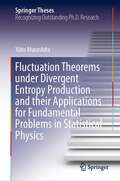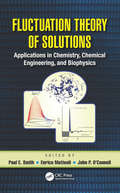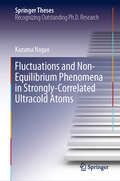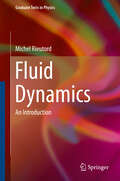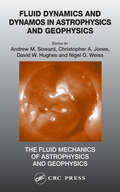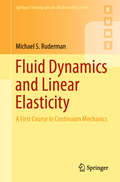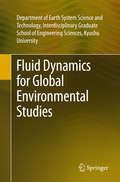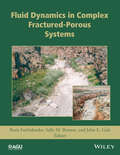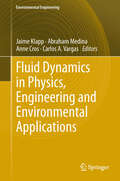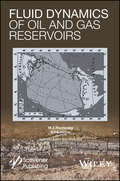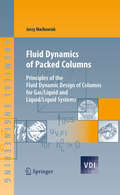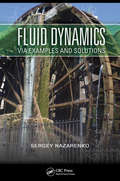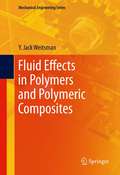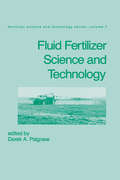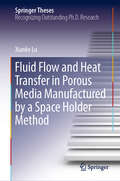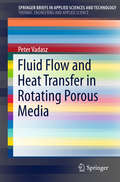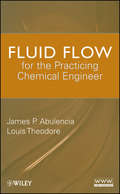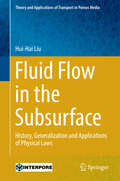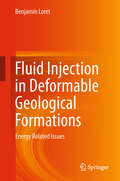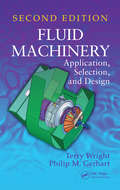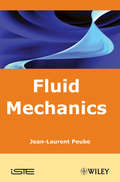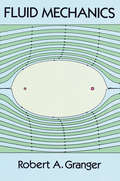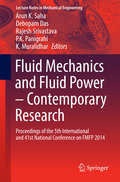- Table View
- List View
Fluctuation Theorems under Divergent Entropy Production and their Applications for Fundamental Problems in Statistical Physics (Springer Theses)
by Yûto MurashitaThis book presents the derivation of the fluctuation theorems with divergent entropy production and their application to fundamental problems in statistical physics. It explores the two basic aspects of the fluctuation theorems: i) Applicability in extreme situations with divergent entropy production, concluding that the fluctuation theorems remain valid under the notion of absolute irreversibility, and ii) utility in the investigation of classical enigmas in the framework of statistical physics, i.e., Gibbs and Loschmidt paradoxes. The book offers readers an overview of the research in fundamental statistical physics. Firstly it briefly but skillfully reviews the modern development of fluctuation theorems to found the key theme of the book. Secondly it concisely discusses historical issues of statistical physics in chronological order, along with the key literature in the field. They help readers easily follow the key developments in the fundamental research of statistical physics.
Fluctuation Theory of Solutions: Applications in Chemistry, Chemical Engineering, and Biophysics
by Paul E. Smith Enrico Matteoli John P. O’ConnellThere are essentially two theories of solutions that can be considered exact: the McMillan-Mayer theory and Fluctuation Solution Theory (FST). The first is mostly limited to solutes at low concentrations, while FST has no such issue. It is an exact theory that can be applied to any stable solution regardless of the number of components and their co
Fluctuations and Non-Equilibrium Phenomena in Strongly-Correlated Ultracold Atoms (Springer Theses)
by Kazuma NagaoThis book discusses non-equilibrium quantum many-body dynamics, recently explored in an analog quantum simulator of strongly correlated ultracold atoms. The first part presents a field-theoretical analysis of the experimental observability of the Higgs amplitude mode that emerges as a relativistic collective excitation near a quantum phase transition of superfluid Bose gases in an optical lattice potential. The author presents the dynamical susceptibilities to external driving of the microscopic parameters, taking into account a leading-order perturbative correction from quantum and thermal fluctuations and shows clear signatures of the Higgs mode in these observables. This is the first result that strongly supports the stability of the Higgs mode in three-dimensional optical lattices even in the presence of a spatially inhomogeneous confinement potential and paves the way for desktop observations of the Higgs mode. In the second part, the author applies the semi-classical truncated-Wigner approximation (TWA) to far-from-equilibrium quantum dynamics. Specifically, he considers the recent experiments on quantum-quench dynamics in a Bose-Hubbard quantum simulator. A direct comparison shows remarkable agreement between the numerical results from TWA and the experimental data. This result clearly indicates the potential of such a semi-classical approach in reliably simulating many-body systems using classical computers. The book also includes several chapters providing comprehensive reviews of the recent studies on cold-atomic quantum simulation and various theoretical methods, including the Schwinger-boson approach in strongly correlated systems and the phase-space semi-classical method for far-from-equilibrium quantum dynamics. These chapters are highly recommended to students and young researchers who are interested in semi-classical approaches in non-equilibrium quantum dynamics.
Fluid Dynamics
by Michel RieutordThis book is dedicated to readers who want to learn fluid dynamics from the beginning. It assumes a basic level of mathematics knowledge that would correspond to that of most second-year undergraduate physics students and examines fluid dynamics from a physicist's perspective. As such, the examples used primarily come from our environment on Earth and, where possible, from astrophysics. The text is arranged in a progressive and educational format, aimed at leading readers from the simplest basics to more complex matters like turbulence and magnetohydrodynamics. Exercises at the end of each chapter help readers to test their understanding of the subject (solutions are provided at the end of the book), and a special chapter is devoted to introducing selected aspects of mathematics that beginners may not be familiar with, so as to make the book self-contained.
Fluid Dynamics
by Peter S. BernardThis book presents a focused, readable account of the principal physical and mathematical ideas at the heart of fluid dynamics. Graduate students in engineering, applied math, and physics who are taking their first graduate course in fluids will find this book invaluable in providing the background in physics and mathematics necessary to pursue advanced study. The book includes a detailed derivation of the Navier-Stokes and energy equations, followed by many examples of their use in studying the dynamics of fluid flows. Modern tensor analysis is used to simplify the mathematical derivations, thus allowing a clearer view of the physics. Peter Bernard also covers the motivation behind many fundamental concepts such as Bernoulli's equation and the stream function. Many exercises are designed with a view toward using MATLAB or its equivalent to simplify and extend the analysis of fluid motion including developing flow simulations based on techniques described in the book.
Fluid Dynamics and Dynamos in Astrophysics and Geophysics (The Fluid Mechanics of Astrophysics and Geophysics)
by Christopher A. Jones David W. Hughes Andrew M. Soward Nigel O. WeissThe increasing power of computer resources along with great improvements in observational data in recent years have led to some remarkable and rapid advances in astrophysical fluid dynamics. The subject spans three distinct but overlapping communities whose interests focus on (1) accretion discs and high-energy astrophysics; (2) solar, stellar, and
Fluid Dynamics and Linear Elasticity: A First Course in Continuum Mechanics (Springer Undergraduate Mathematics Series)
by Michael S. RudermanThis book provides a concise introduction to continuum mechanics, with a particular emphasis on fluid dynamics, suitable for upper undergraduate students in applied mathematics and related subjects.Starting with a preliminary chapter on tensors, the main topic of the book begins in earnest with the chapters on continuum kinematics and dynamics. Following chapters cover linear elasticity and both incompressible and compressible fluids. Special topics of note include nonlinear acoustics and the theory of motion of viscous thermal conducting compressible fluids.Based on an undergraduate course taught for over a decade, this textbook assumes only familiarity with multivariate calculus and linear algebra. It includes many exercises with solutions and can serve as textbook for lecture courses at the undergraduate and masters level.
Fluid Dynamics for Global Environmental Studies
by Dept. Earth Sys Sci. Tech. Interdis.Grad Sch Engg Sci Kyushu Univ.This book introduces the basic concepts of environmental fluid dynamics. It is intended for use by students, researchers, engineers, and specialists working not only in general fluid research but also in the atmospheric and oceanic research fields. The Earth is covered by atmosphere and oceans and is exposed to solar wind. Therefore, the knowledge of fluid dynamics is essential for tackling its environmental issues. Although many textbooks have treated fluid dynamics, practically no book has been published that clearly describes all essential ideas, from the fundamentals of fluid dynamics to advanced environmental sciences, with careful sequential explanations of the governing mathematics. This book has been developed to solve these educational problems and has actually been in use in lectures in the graduate school of Kyushu University for more than 15 years.
Fluid Dynamics in Complex Fractured-Porous Systems
by Boris Faybishenko Sally M. Benson John E. GaleDespite of many years of studies, predicting fluid flow, heat, and chemical transport in fractured-porous media remains a challenge for scientists and engineers worldwide. This monograph is the third in a series on the dynamics of fluids and transport in fractured rock published by the American Geophysical Union (Geophysical Monograph Series, Vol. 162, 2005; and Geophysical Monograph, No. 122, 2000). This monograph is dedicated to the late Dr. Paul Witherspoon for his seminal influence on the development of ideas and methodologies and the birth of contemporary fractured rock hydrogeology, including such fundamental and applied problems as environmental remediation; exploitation of oil, gas, and geothermal resources; disposal of spent nuclear fuel; and geotechnical engineering. This monograph addresses fundamental and applied scientific questions and is intended to assist scientists and practitioners bridge gaps in the current scientific knowledge in the areas of theoretical fluids dynamics, field measurements, and experiments for different practical applications. Readers of this book will include researchers, engineers, and professionals within academia, Federal agencies, and industry, as well as graduate/undergraduate students involved in theoretical, experimental, and numerical modeling studies of fluid dynamics and reactive chemical transport in the unsaturated and saturated zones, including studies pertaining to petroleum and geothermal reservoirs, environmental management and remediation, mining, gas storage, and radioactive waste isolation in underground repositories. Volume highlights include discussions of the following: Fundamentals of using a complex systems approach to describe flow and transport in fractured-porous media. Methods of Field Measurements and Experiments Collective behavior and emergent properties of complex fractured rock systems Connection to the surrounding environment Multi-disciplinary research for different applications
Fluid Dynamics in Physics, Engineering and Environmental Applications
by Jaime Klapp Abraham Medina Anne Cros Carlos A. VargasThe book contains invited lectures and selected contributions presented at the Enzo Levi and XVII Annual Meeting of the Fluid Dynamic Division of the Mexican Physical Society in 2011. It is aimed to fourth year undergraduate and graduate students, and scientists in the field of physics, engineering and chemistry that have interest in Fluid Dynamics from the experimental and theoretical point of view. The invited lectures are introductory and avoid the use of complicate mathematics. The other selected contributions are also adequate to fourth year undergraduate and graduate students. The Fluid Dynamics applications include multiphase flow, convection, diffusion, heat transfer, rheology, granular material, viscous flow, porous media flow, geophysics and astrophysics. The material contained in the book includes recent advances in experimental and theoretical fluid dynamics and is adequate for both teaching and research.
Fluid Dynamics of Oil and Gas Reservoirs
by M. Z. Rachinsky V. Y. KerimovWhether as a textbook for the petroleum engineering student or areference for the veteran engineer working in the field, this newvolume is a valuable asset in the engineer's library for new,tested methods of more efficient oil and gas exploration andproduction and better estimating methods. In this book, theauthors combine a rigorous, yet easy to understand, approach topetrophysics and how it is applied to petroleum and environmentalengineering to solve multiple problems that the engineer orgeologist faces every day. Useful in the prediction ofeverything from crude oil composition, pore size distribution inreservoir rocks, groundwater contamination, and other types offorecasting, this approach provides engineers and students alikewith a convenient guide to many real-world applications. Fluid dynamics is an extremely important part of the extractionprocess, and petroleum geologists and engineers must have a workingknowledge of fluid dynamics of oil and gas reservoirs in order tofind them and devise the best plan for extraction, before drillingcan begin. This book offers the engineer and geologist afundamental guide for accomplishing these goals, providingmuch-needed calculations and formulas on fluid flow, rockproperties, and many other topics that are encountered everyday. The approach taken in Fluid Dynamics of Oil and GasReservoirs is unique and has not been addressed until now in abook format. Readers now have the ability to review some of themost well-known fields in the world, from the USA to Russiaand Asia. Useful for the veteran engineer or scientist and the studentalike, this book is a must-have for any geologist, engineer, orstudent working in the field of upstream petroleum engineering.
Fluid Dynamics of Packed Columns
by Claudia Hall Jerzy MackowiakThis book provides support to engineers as well as graduate students in their daily design work within the industry or for the development of new plants. It investigates the key issues relating to the fluid dynamic design of packed columns used in rectification, absorption and stripping (desorption) under vacuum, normal pressure and up to 100 bar and liquid-liquid-extraction, which are relevant in waste air and wastewater technology. The author presents a standardised model, which is valid for any type of packing and can be used to calculate the gas velocity at flooding point as well as the liquid hold-up and the pressure drop throughout the entire operating range for random packings, stacked packings elements, tube columns and structured packings with different flow channel angles. The book also contains packing parameter data for approx. 200 random and structured packings. In addition to outlining the fundamental principles of fluid dynamics, it presents numerous examples of practical application.
Fluid Dynamics via Examples and Solutions
by Sergey NazarenkoFluid Dynamics via Examples and Solutions provides a substantial set of example problems and detailed model solutions covering various phenomena and effects in fluids. The book is ideal as a supplement or exam review for undergraduate and graduate courses in fluid dynamics, continuum mechanics, turbulence, ocean and atmospheric sciences, and relate
Fluid Dynamics: An Introduction (Graduate Texts in Physics)
by Michel RieutordThis book is dedicated to readers who want to learn fluid dynamics from the beginning. It assumes a basic level of mathematics knowledge that would correspond to that of most second-year undergraduate physics students and examines fluid dynamics from a physicist’s perspective. As such, the examples used primarily come from our environment on Earth and, where possible, from astrophysics. The text is arranged in a progressive and educational format, aimed at leading readers from the simplest basics to more complex matters like turbulence and magnetohydrodynamics. Exercises at the end of each chapter help readers to test their understanding of the subject (solutions are provided at the end of the book), and a special chapter is devoted to introducing selected aspects of mathematics that beginners may not be familiar with, so as to make the book self-contained.
Fluid Effects in Polymers and Polymeric Composites
by Y. Jack WeitsmanFluid Effects in Polymers and Polymeric Composites, written by the late Dr. Y. Jack Weitsman, addresses the wide range of parameters that affect the interaction of fluids with polymers and polymeric composites. The book aims at broadening the scope of available data, mostly limited up to this time to weight-gain recordings of fluid ingress into polymers and composites, to the practical circumstances of fluctuating exposure. Various forms of experimental data are given, in conjunction with theoretical models derived from basic scientific principles, and correlated with severity of exposure conditions and interpreted by means of rationally based theoretical models. The practical implications of the effects of fluids are discussed. The issue of fluid effects on polymers and polymeric composites is of concern to engineers and scientists active in aerospace and naval structures, as an increasing portion of these structures are made of polymeric composites and employ polymeric adhesives as a joining device. While the book is intended for this audience, it will also interest researchers and graduate students interested in the mechanics and materials aspects of this matter.
Fluid Fertilizer Science and Technology: Proceedings No 514
by Derek A. PalgraveIllustrates current fluid fertilizer technology in the US and abroad, including manufacture, handling, storage, distribution, and use in the field demonstrating how fluid fertilizer facilitates more precise delivery of nutrition to crops. The volume provides the means to analyze fluid fertilizer sys
Fluid Flow and Heat Transfer in Porous Media Manufactured by a Space Holder Method (Springer Theses)
by Xianke LuThis book focuses on the effects of the material, porosity, pore size and pore shape on flow behaviour and heat transfer in microscale porous media manufactured using a space holder method. It also describes a novel approach to studying flow behaviour in non-transparent materials such as porous metals via flow visualization in transparent media that mimic the porous structure. The book employs a combination of microparticle image velocimetry – a modern, advanced technique – and pressure drop measurement – a more traditional method – that makes the mechanistic study of several phenomena possible. It covers the identification of various flow regimes and their boundaries, velocity profiles on the microscale, the heat transfer coefficient under forced convection, and the correlation between flow behaviour on the pore scale and the convective heat transfer performance of the porous media. Understanding the fundamentals of porous flow, especially on the microscale, is critical for applications of porous media in heat exchangers, catalytic convertors, chemical reactors, filtration and oil extraction. Accordingly, this book offers a valuable resource for all researchers, graduate students and engineers working in the areas of porous flow and porous materials.
Fluid Flow and Heat Transfer in Rotating Porous Media
by Peter VadaszThis Book concentrates the available knowledge on rotating fluid flow and heat transfer in porous media in one single reference. Dr. Vadasz develops the fundamental theory of rotating flow and heat transfer in porous media and introduces systematic classification and identification of the relevant problems. An initial distinction between rotating flows in isothermal heterogeneous porous systems and natural convection in homogeneous non-isothermal porous systems provides the two major classes of problems to be considered. A few examples of solutions to selected problems are presented, highlighting the significant impact of rotation on the flow in porous media.
Fluid Flow for the Practicing Chemical Engineer
by Louis Theodore James P. AbulenciaThis book teaches the fundamentals of fluid flow by including both theory and the applications of fluid flow in chemical engineering. It puts fluid flow in the context of other transport phenomena such as mass transfer and heat transfer, while covering the basics, from elementary flow mechanics to the law of conservation. The book then examines the applications of fluid flow, from laminar flow to filtration and ventilization. It closes with a discussion of special topics related to fluid flow, including environmental concerns and the economic reality of fluid flow applications.
Fluid Flow in the Subsurface
by Hui-Hai LiuThis book presents a systematic attempt to generalize several fundamental physical laws related to subsurface fluid flow that are important for a number of contemporary applications in the areas of hydrogeology, reservoir engineering and rock mechanics. It also covers the history of discovering these physical laws, their respective scope of validity, and their generalizations or extensions. The physical laws discussed include Darcy s law, Darcy-Buckingham law and Hooke s law. Darcy s law is the fundamental law for subsurface fluid flow. For low-permeability media, it is not always adequate because of the strong fluid solid interaction. Though the Darcy-Buckingham law is often used for modeling subsurface multiphase flow, it is only valid under the local equilibrium condition. This condition does not hold in many cases, especially when fingering flow occurs. It is well known that subsurface fluid flow is coupled with mechanical deformation of subsurface media; in some applications, this coupling can play a dominant role. The continuum-scale elastic deformation of natural rock, however, does not always follow the traditional form of Hooke s law. The book also presents applications of the proposed generalizations of the physical laws to several important engineering projects. "
Fluid Injection in Deformable Geological Formations: Energy Related Issues
by Benjamin LoretThis book offers an introduction to the geomechanical issues raised by both the extraction of actual and potential energy resources, and by the treatment of the ensuing environmental concerns. Discussions of the operations of injection of fluids into, and withdrawal from, geological formations link the chapters, each devoted to a particular technical aspect or scientific issue, or to a particular energy resource.Subjects are ordered according to their industrial applications, including enhanced oil and gas recovery, gas hydrates, enhanced geothermal systems, hydraulic fracturing, and carbon dioxide sequestration. An overview of the industrial, research and simulation aspects for each subject is provided. Fluid Injection in Deformable Geological Formations will be of interest to academic and industrial researchers in a wide variety of fields, including computational mechanics, civil engineering, geotechnical engineering and geomechanics, engineering seismology, petroleum engineering, reservoir engineering, and engineering geology.
Fluid Machinery: Application, Selection, and Design, Second Edition
by Terry Wright Philip GerhartPublished nearly a decade ago, Fluid Machinery: Performance, Analysis, and Design quickly became popular with students, professors, and professionals because of its comprehensive and comprehensible introduction to the fluid mechanics of turbomachinery. Renamed to reflect its wider scope and reorganized content, this second edition provides a more l
Fluid Mechanics
by Jean-Laurent PuebeThis book examines the phenomena of fluid flow and transfer as governed by mechanics and thermodynamics. Part 1 concentrates on equations coming from balance laws and also discusses transportation phenomena and propagation of shock waves. Part 2 explains the basic methods of metrology, signal processing, and system modeling, using a selection of examples of fluid and thermal mechanics.
Fluid Mechanics (Dover Books on Physics)
by Robert A. Granger"The mixture of prose, mathematics, and beautiful illustrations is particularly well chosen." -- American ScientistThis monumental text by a noted authority in the field is specially designed to provide an orderly structured introduction to fluid mechanics, a field all too often seen by students as an amorphous mass of disparate equations instead of the coherent body of theory and application it should be. In addition, the book will help upgrade students' mathematical skills as they learn the fundamentals of fluid mechanics.The text presents a unified method of analysis that poses fluid mechanics problems in precise mathematical language without becoming stiff or unnecessarily rigorous. This method involves three steps: First, the text carefully defines each problem so the student knows what is given and what is missing. Second, each chapter treats the physical aspects of the problems so the student can visualize how things work in the real world. Third, the text represents the physical model by appropriate mathematical symbols and operators, collects these into equations, and then solves them. The result is a superb learning and teaching process that covers everything the engineer needs to know -- nature of fluids, hydrostatics, differential and integral equations, dimensional analysis, viscous flows, and other topics -- while allowing students to see each element in its relation to the whole.Each chapter contains numerous examples incorporating problem-solving techniques, demonstrations to illustrate topical material, study questions, boxed equations of significant results, appropriate references to supplementary materials and other study aids. Over 760 illustrations enhance the text. This volume will be an indispensable reference and resource for any student of fluid mechanics or practicing engineer.
Fluid Mechanics and Fluid Power – Contemporary Research
by Rajesh Srivastava Arun K. Saha Debopam Das P. K. Panigrahi K. MuralidharThis volume comprises the proceedings of the 42nd National and 5th International Conference on Fluid Mechanics and Fluid Power held at IIT Kanpur in December, 2014. The conference proceedings encapsulate the best deliberations held during the conference. The diversity of participation in the conference, from academia, industry and research laboratories reflects in the articles appearing in the volume. This contributed volume has articles from authors who have participated in the conference on thematic areas such as Fundamental Issues and Perspectives in Fluid Mechanics; Measurement Techniques and Instrumentation; Computational Fluid Dynamics; Instability, Transition and Turbulence; Turbomachinery; Multiphase Flows; Fluid‐Structure Interaction and Flow‐Induced Noise; Microfluidics; Bio‐inspired Fluid Mechanics; Internal Combustion Engines and Gas Turbines; and Specialized Topics. The contents of this volume will prove useful to researchers from industry and academia alike.
